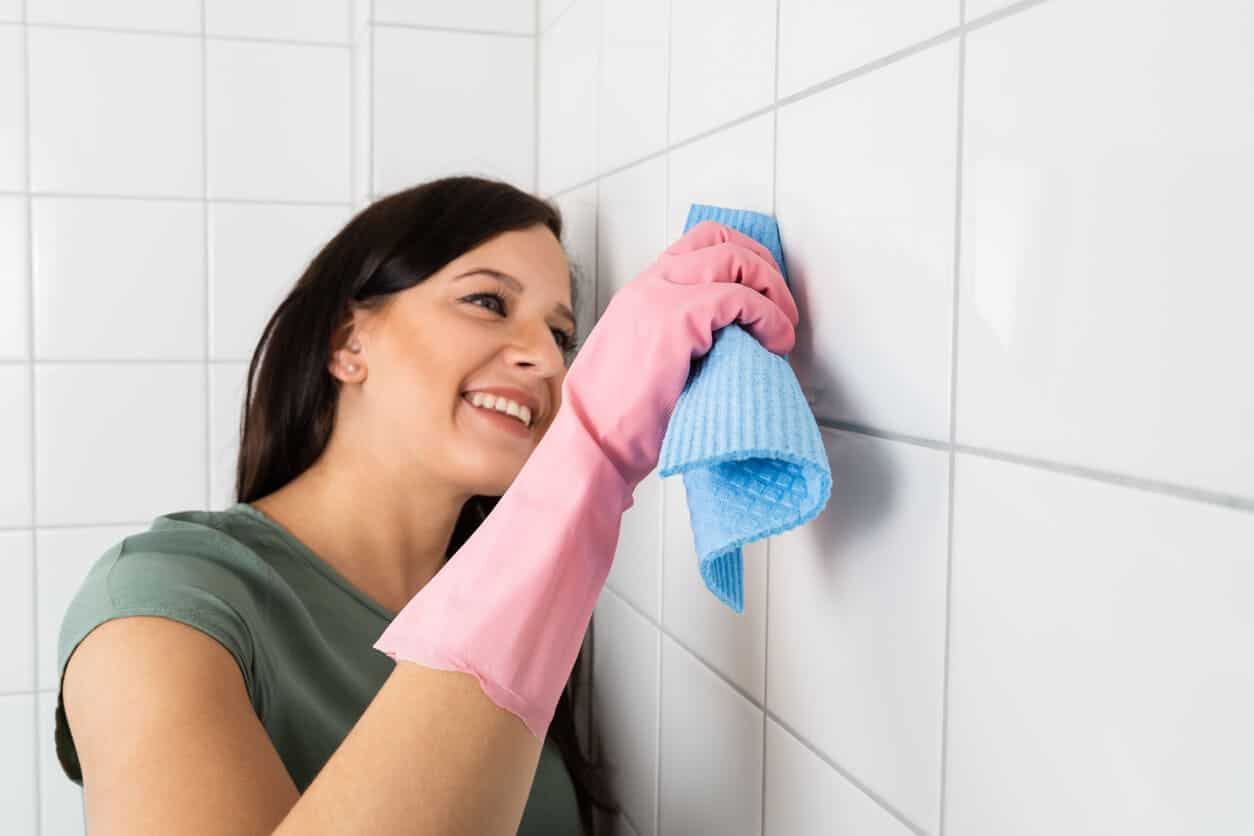Hair coloring experiments at home are fun, but they often result in some dye splashes and stains in the most unexpected places.
Hair dyes are designed to be long lasting as possible, which makes them one of the hardest to get off the surfaces. Keep on reading for the best ways to remove hair dye from walls.
Hair dye stains take a bit of effort to remove, but toothpaste, nail polish remover, and bleach generally work well on a tiled bathroom wall.
On painted walls, you can use hydrogen peroxide to remove the stain, or simply paint over the stain. For wallpaper stains, a solution of water and detergent could work.
Let’s learn more about these cleaning methods.
Also Read: How To Clean Foundation Brush: Complete Guide!
What’s in Hair Dyes?
To achieve a permanent color, hair dyes are composed of hydrogen peroxide, ammonia, and coloring agents that can withstand water, shampoos, and mild detergents.
Technically, hydrogen peroxide bleaches the hair, while ammonia pulls apart hair proteins, so that the coloring agents will be trapped in the hair.
Sometimes, hair dyes also contain alcohol to increase absorption, leading to rich hair color. The chemical makeup of hair dyes makes the color long-lasting, so it’s not surprising that they also make stubborn stains.
A Step-By-Step Guide On Removing Hair Dye Stains From Walls
Removing stains isn’t always a straightforward process, as you’ll need something that will dissolve the dye without damaging the wall finish, especially if it has a porous surface or is painted.
Luckily, most cleansers you’ll need are regular household items. Different types of surfaces respond differently to a variety of cleansers, so we rounded up the ones you should use.
On tiled bathroom walls
Most shower walls come with porcelain and ceramic tiles, which are easier to deal with. Whether the dye stain is old or new, the following steps could work.
Step 1:
Apply a good amount of dish soap to the stain and scrub the spot with a sponge. It should work for fresh hair dye stains that didn’t dry out completely.
Step 2:
Make use of toothpaste and toothbrush to remove the dye stain. Hair dyes contain hydrogen peroxide, but the active ingredient is also present in toothpaste. It’s the thing that bleaches the old stains to reveal a whiter smile, so why not use it on your walls?
Step 3:
If you have white bathroom walls, you can also use an acetone-based nail polish remover. However, it shouldn’t be used on colorful tiles as it can also remove the color from the surface. Just soak the cotton ball on it and scrub the dye stain.
Step 4:
Use bleach to remove the dye stain. Simply create a solution of equal parts bleach and water. You may dip a washcloth into the bleach solution and wipe the stain until it’s gone. Just don’t forget to wear old clothes and rubber gloves when working with bleach.
On marble walls
Marble walls and countertops aren’t porous, so they’re also easy to clean up.
However, marble is made up of calcium carbonate, which reacts with alkaline and acidic substances. Avoid using bleach and vinegar on marble walls, as they can corrode the polished layer on the surface.
Step 1:
Use baking soda with caution. While you shouldn’t use the abrasive cleaner on marble walls every day, you could use it once to remove the dye stains.
Simply create a baking soda solution with water, but only use a soft cloth for removing the stain. Make sure to rinse with water, so that the solution won’t be in contact with the marble surface longer than necessary.
Step 2:
If the above steps didn’t work out, it may be time to invest in a professional color and stain removal solution. WD-40 is one of the best brands out there to help you get the job done.
Most of their products remove grease, grime, and rust, which could also work on stubborn hair dye stains.
On painted walls
Removing hair dye stains from a painted wall is more challenging than tiled walls. This is especially true if the dye stain already seeped deeper into the layers of paint.
More than that, you should clean your walls according to their paint finish, as scrubbing could also affect the appearance of a painted wall.
Step 1:
Use the popular Magic Eraser from Mr. Clean(link to amazon), as it does wonder on stained walls. Simply wet the eraser under running water and squeeze the sponge to remove the excess.
Scrub the dye stain until it’s completely removed from the wall. It works best on glossy and semi-gloss finishes, though the paint could be scratched with aggressive scrubbing.
Step 2:
For latex-painted walls, use water and baking soda to remove the dye stain. Instead of a magic eraser, use a sponge that’s less abrasive, and gently rub the wall.
Step 3:
If the above step didn’t work out, use hydrogen peroxide to remove the stain. Create a solution of 3% peroxide with water and soak a cotton swab or cotton ball on it.
Simply blot the dye stain with a cotton ball until it’s removed. While you can repeat the process three times, overdoing it could also damage the wall.
Step 4:
If all else fails, paint over the stain. A small bit of paint can cover up the spot as if there was never a dye stain on it.
It’s the best remedy for eggshell, satin, and flat finishes, as those paints are less durable. If you live in an apartment complex, you could ask the maintenance to provide you with paint free of charge.
On wallpapers
If the hair dye stain gets stuck and dries on the wallpaper, it would be extremely challenging to remove. Most cleansers like bleach, nail polish remover, and rubbing alcohol can cause discoloration, doing more harm than good.
Step 1:
Use a solution of water and detergent to remove the dye stain. Just make sure that the cloth is damp and not soaking wet, as water can make the stain spread. Rub the surface until the stain becomes less visible.
Step 2:
If the hair dye stain didn’t come off at all, think of covering the area with the same colored wallpaper, which could camouflage the spot.
Also Read: 7 Tips On How To Clean Clogged Pores
Related Questions
Can you remove hair dye stains from wood?
Yes, though it’s more challenging on wood surfaces that aren’t painted or varnished.
You can make a solution of detergent, baking soda, and water, and rub the area with a cloth until the dye stain disappears. However, water shouldn’t be in long contact with wood, so dry the spot as soon as the stain comes off.
If the dye stain is still visible, think of a solution of lemon juice and baking soda, mixing equal parts to make a thick paste. Instead of a cloth, use a Magic Eraser on scrubbing the surface.
Repeat the process until the dye stain is gone.
What’s the easiest way to remove dye stains from sinks and bathtubs?
Since these surfaces aren’t porous, you can use a thick paste of vinegar and baking soda to remove the stain. You may also use hot water to dissolve the dye and leave the paste on the surface for 1 hour.
Scrub the stain with a cloth or sponge, and repeat the process until the hair dye stain disappears. A great thing, the sour smell of vinegar can easily be washed away with dish soap.
How to keep from permanently staining walls and surfaces?
Prepare your workspace before mixing up your color, and remove items that might get stained. Make use of old newspaper to cover the walls and surfaces, and keep a roll of paper towels nearby.
Also, have your cleaning products handy, such as a sponge, detergent, and bleach in case dye splatters end up on walls. After all, it’s easier to blot and remove fresh dye stains than to deal with dried, stubborn marks.
How to remove hair dye stains from bathroom carpet without using bleach?
Instead of bleach, use vinegar mixed with detergent to remove the stain. Use a damp cloth or sponge to rub the spot, but blot frequently until the surface is dry.
You may repeat the process until the stain is completely removed. This method is more effective when you use it as soon as the carpet is stained.

